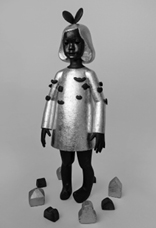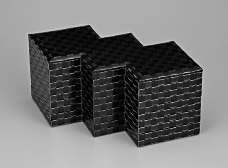Discussion
審査講評(5)
Comments on Silver Prize Winners

へいわののりもの(おんなのこ)
Vehicle of Peace (Girl)
H103×W50×D50
2017

Ichimatsu 3 Colors
H16×W40×D20
2017
Ohnishi ───── Thank you. Next, on to the Silver Prize winners. The first work is ‘Vehicle of Peace (Girl)’ by Mr Ichizo Ino who is actively involved in Urushi art in Kanazawa. I can imagine that he modelled this sculptural piece on his daughter, as I have seen the warmth in his face when he looks at her. He excellently expresses the loving relationship between himself and his daughter in the calm movement of his three-dimensional work.
The work has two parts, in gold leaf and black Urushi. It is three dimensional yet at the same time gives an interesting binary contrast between the colors of gold and black. The material and texture is that which only Urushi can bring out. He expresses his daughter’s child-like movement through his warmth of feeling. Although the figure is not realistic, the simple work is full of emotion.
He has created similar works and shown them at various venues. Each work represents his vision and mind in a new and vivid way. Such types of figures tend to be ordinary doll-like ones, but his are different. The Urushi and the technique Kanshitsu are finely integrated to create this lovely and beloved work. It is far from realistic, but when you look at the girl you will find yourself smiling unconsciously.
Next we have the Silver Prize winner, Mr Hiroyuki Yoshida’s ‘Ichimatsu 3 Colors’, a set of Urushi plates. Mr Yoshida has submitted works to the exhibition many times. During these years, his work has been improving and becoming more sophisticated. All the jurors are counting on his future success. We would like Mr Motomi Kawakami to make comments on ‘Ichimatsu 3 Colors’.
Kawakami ───── This was my first time participating in the Final Assessment for the Ishikawa International Urushi Exhibition. The Silver Prize winner entitled ‘Ichimatsu 3 Colors’ is a set of ten stackable trays shaped as three squares connected diagonally. The checkered pattern is done with the Suki Urushi technique. The forms of the stacked trays create movement which results in an interesting view. Considering the opportunities to use this work, think of the fun of setting, not square, not rectangular, but zigzag-shaped trays on the table, with limitless possibilities for the arrangement of food. This piece encourages enjoyable thoughts of the many ceremonial uses it could have.
However, during our assessment some jurors had a sense of déjà vu. I did not realize because I am a newcomer in the assessment panel, but it turned out that he has been awarded before on his series of checkered-patterned works. However, we believe that each time his work has improved and I felt that his effort to continue to create his works on one particular theme is wonderful.
I, myself, have used Suki Urushi food containers and bowls for nearly 30 years, and I have grown wholly accustomed to them. Suki Urushi for me is a technique, method and ware we have enjoyed for a long time. The checkered patterns here are colored in black, vermillion and yellow, the three colors of the name. The pattern is stylish and modern. Now the colors are vibrant, but they will gradually and delicately mellow with time, which will add to the work’s expression. This work is quite magnificent, I feel.
